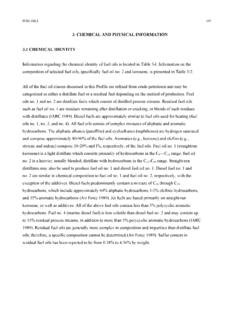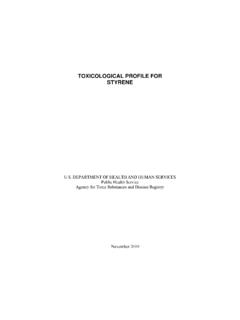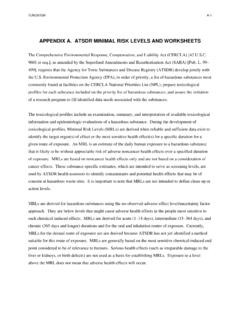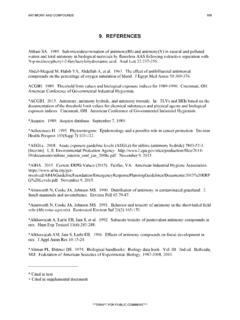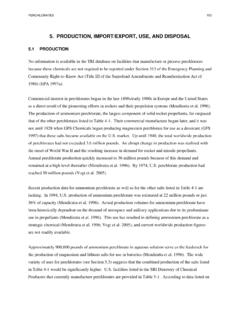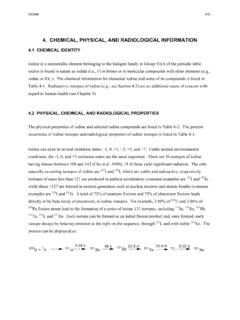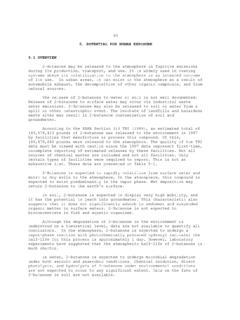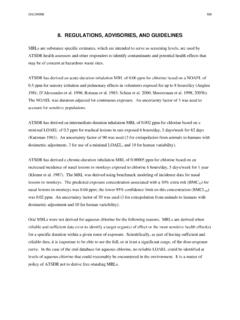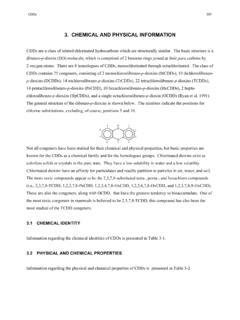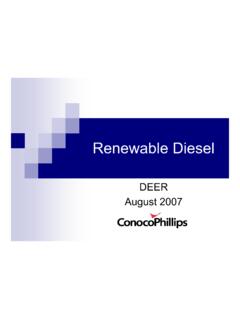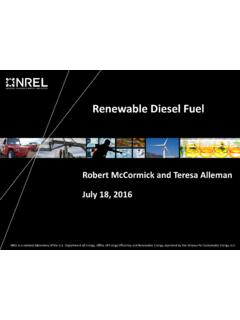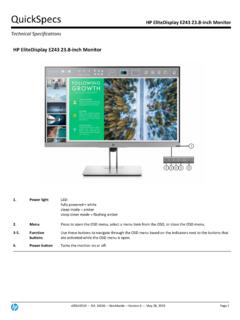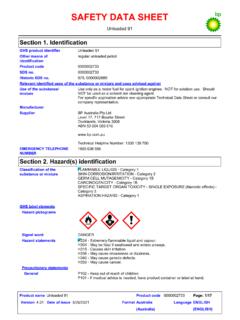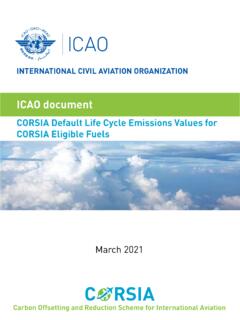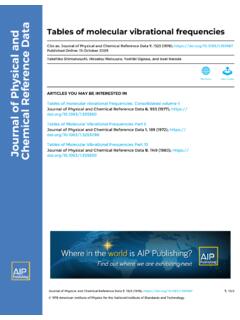Transcription of 4. CHEMICAL AND PHYSICAL INFORMATION - Agency for …
1 145 JP-5, JP-8 , AND JET A FUELS 4. CHEMICAL AND PHYSICAL INFORMATION CHEMICAL IDENTITY INFORMATION regarding the CHEMICAL identities of JP-5, JP-8, and Jet A fuels is located in Table 4-1. Nearly all jet fuel is made from kerosene derived from petroleum; however, a small percentage is made from oil sands (Chevron 2006). Kerosene is manufactured from the distillation of crude oil at atmospheric pressure (straight-run) or from catalytic, thermal, or steam cracking of heavier petroleum streams (cracked kerosene). Figure 4-1 depicts a general schematic of a refinery capable of producing jet fuels along with other light, middle, and heavy distillates of crude oil. The exact composition of any particular batch of jet fuels is dependent upon the crude oil from which it was derived and on the refinery processes used for its production.
2 Regardless of the source and production process, kerosenes and jet fuels primarily consist of C9 to C16 hydrocarbons that boil in the range of 145 300 C (API 2010a). Analytical techniques are not capable of separating and characterizing each molecular species of these complex mixtures (likely >1,000 individual components); however, the predominant components of jet fuels are branched and linear paraffins and naphthenes (cycloalkanes) which usually account for over 70% of the components by volume (API 2010a; Chevron 2006). Aromatic hydrocarbons such as alkylbenzenes and naphthalenes do not exceed 25% of the total. Olefins represent an insignificant fraction of the total composition of JP-5, JP-8, and Jet A fuels. The final product must meet all of the performance and regulatory requirements of the specific fuel. ASTM International (formerly known as the American Society for Testing and Materials) and the Ministry of Defense publish specifications and test methods for commercial jet fuels and more INFORMATION regarding these standards may be obtained from these organizations.
3 These requirements, including a description on the different additives used in aviation fuels have been summarized in an ExxonMobil report on world jet fuel specifications (ExxonMobil 2005). The government and other nations governments maintain specifications for jet fuels for military use (Chevron 2006). Two important types of jet fuels exist for commercial aviation, Jet A and Jet A-1. Jet A is predominantly used in the continental United States while Jet A-1 is used throughout the rest of the world (ExxonMobile 2005). These fuels are nearly identical; however the most important difference between them is that Jet A-1 is refined to have a lower maximum freezing point (-47 C) than Jet A (-40 C). The lower freezing point makes Jet A-1 a better choice for international flights, especially on polar routes during the winter season (Chevron 2006).
4 In addition, Jet A typically does not contain a static dissipator additive that may be required for Jet A-1 fuels (ExxonMobil 2005). Table 4-2 lists some compositional data for 14 different Jet A fuel samples provided by the American Petroleum Institute (API). 146 JP-5, JP-8, AND JET A FUELS 4. CHEMICAL AND PHYSICAL INFORMATION Table 4-1. CHEMICAL Identity of JP-5, JP-8, and Jet A Fuels Characteristic INFORMATION CHEMICAL name JP-5 JP-8 Jet A Synonym(s) NATO F-44; AVCAT; NATO F-34; AVTUR; MIL-No data aviation kerosene; DTL-83133H; aviation kerosene; fuel oil no. 1; kerosene; kerosene; fuel jet kerosene; turbo fuel A; oil no. 1; jet kerosene; straight run kerosene; turbo fuel A; straight run distillate fuel oils, kerosene; distillate fuel lighta,b,c,d oils, lighta,b,c,d,e Registered trade No data No data No data name(s) CHEMICAL formulaf No data No data No data CHEMICAL structuref No data No data No data Identification numbers: CAS registry 8008-20-6g/70892-10-3h 8008-20-6g/70892-10-3h 8008-20-6g/70892-10-3h NIOSH RTECS OA5500000b (kerosene) OA5500000b (kerosene) OA5500000b (kerosene) EPA hazardous No data No data No data waste OHM/TADS 7217063g (kerosene) 7217063g (kerosene) 7217063g (kerosene) DOT/UN/NA/IMDG UN 1223; IMO UN 1223; IMO UN 1223.
5 IMO shipping (kerosene) (kerosene) (kerosene) HSDB 632b (kerosene) 632b (kerosene) 632b (kerosene) NCI No data No data No data aRTECS 1998 bHSDB 2012 cIARC 1989 dArmy 1988 eDOD 2013 fFuel oils are mixtures of various hydrocarbons designed to meet specifications set forth by the American Society for Testing and Materials (DOD 1992); therefore, CHEMICAL structure and CHEMICAL formula cannot be determined. gNTP/NIH 1986hOHM/TADS 1985 CAS = CHEMICAL Abstracts Service; DOT/UN/NA/IMDG = Department of Transportation/United Nations/North America/International Maritime Dangerous Goods Code; EPA = Environmental Protection Agency ; HSDB = Hazardous Substances Data Bank; NCI = National Cancer Institute; NIOSH = National Institute for Occupational Safety and Health; OHM/TADS = Oil and Hazardous Materials/Technical Assistance Data System; RTECS = Registry of Toxic Effects of CHEMICAL Substances 147 JP-5, JP-8, AND JET A FUELS 4.
6 CHEMICAL AND PHYSICAL INFORMATION Figure 4-1. Kerosene/Jet Fuel Processing Adapted from API 2010a; Chevron 2006 148 JP-5, JP-8, AND JET A FUELS 4. CHEMICAL AND PHYSICAL INFORMATION Table 4-2. Compositional Analysis of 14 Samples of Jet A Fuel Average weight Minimum weight Maximum weight Component percentage percentage percentage Hydrocarbon types by mass spectrometry ASTM Method D2425 Paraffins Monocycloparaffins Dicycloparaffins Tricycloparaffins Benzenes Indanes/tetralins CnH2n 10 Naphthalene Naphthalenes CnH2n 14 CnH2n 16 CnH2n 18 Total aromatics Total olefins Total paraffins + napthenes Total aromatics by gas chromatography/mass spectrometry ASTM Method D5769 Benzene Toluene Ethylbenzene m,p-xylene 1,2-Dimethylbenzene Isopropylbenzene Propylbenzene 1-Methyl-3-ethylbenzne 1-Methyl-4-ethylbenzne 1,3,5-Trimethylbenzene 1-Methyl-2-ethylbenzene 1,2,4-Trimethylbenzene 1,2.
7 3-Trimethylbenzene Indane Alkyl Indanes 1,4-Diethyl + butylbenzene 1,2-Diethylbenzene 1,2,4,5-Trimethyl benzene 1,2,3,5-Tetramethylbenzene Total C10 benzenes Total C11 benzenes Total C12 benzenes Naphthalene 149 JP-5, JP-8, AND JET A FUELS 4. CHEMICAL AND PHYSICAL INFORMATION Table 4-2. Compositional Analysis of 14 Samples of Jet A Fuel Average weight Minimum weight Maximum weight Component percentage percentage percentage 2-Methylnaphthalene 1-Methylnaphthalene Source: API (2010b) 150 JP-5, JP-8, AND JET A FUELS 4. CHEMICAL AND PHYSICAL INFORMATION The military uses two kerosene-based aircraft fuels, JP-5 and JP-8.
8 JP-8 is the military equivalent of Jet A-1; however, it contains a corrosion inhibitor and anti-icing additive that is not required in the ASTM specification of Jet A-1. The primary difference between the two military fuels is that the flash point temperature for JP-5 is higher (60 C) as compared to JP-8 (38 C). The higher flash point for JP-5 is more suitable for safe handling and fueling practices aboard aircraft carriers and this is the primary fuel used by the Navy (Chevron 2006). An important additive for military fuels is enhanced thermal stability additives. Jet fuels act as a heat sink for modern aircraft engines. They absorb heat from engine oil, hydraulic fluid and air conditioning apparatus (Chevron 2006). Jet fuels used for high performance military aircraft engines have even greater need of thermal stability as compared to commercial aviation fuels.
9 In the late 1990s, the Air Force began development of an additive to increase the thermal stability of jet fuels. JP-8 fuel containing this additive package is usually referred to as JP-8+100 because this additive increased the thermal stability of the fuel by 100 F; however, this particular additive is not currently approved for use in commercial aircraft fuels (Chevron 2006). Beginning in 2013, the Air Force began using Jet A (plus additives) rather than JP-8 for continental flight usage in order to save on fuel costs (Air Force 2013). Potter and Simmons provided general compositional data for JP-5 and JP-8 fuels and these data are provided in Tables 4-3 and 4-4, respectively. PHYSICAL AND CHEMICAL PROPERTIES INFORMATION regarding the PHYSICAL and CHEMICAL properties of Jet A, JP-5, and JP-8 is located in Table 4-5. In summary, the composition of Jet A/A-1, JP-5, and JP-8 are very similar.
10 They consist predominantly of C9 C16 hydrocarbons that are a combination of n-paraffins, isoparaffins, naphthenes, and aromatics. The paraffin and napthene fraction typically compose over 70% of the fuels by weight, while the aromatic fraction is 25%. Olefins typically comprise <1% of the total. The important differences in the fuels relates to certain PHYSICAL properties and the inclusion of particular additives to enhance performance. Jet A-1 has a lower maximum freezing point (-47 C) than Jet A (-40 C); JP-8 is the military equivalent to Jet A-1, but contains certain additives that are not required in Jet A-1; and JP-5 is formulated to have a higher flash point temperature (60 C) than JP-8 (38 C). 151 JP-5, JP-8, AND JET A FUELS 4. CHEMICAL AND PHYSICAL INFORMATION Table 4-3.
